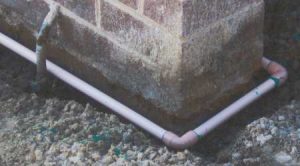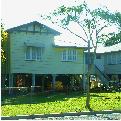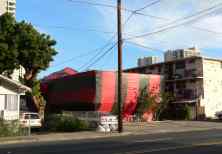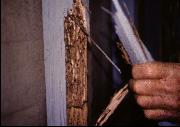- 1. Control
They say I need a treatment too.
This is a tricky one, and this answer is only for subterranean termites (not for drywoods and not for dampwoods).
Let's say the termites are in your neighbor's house. A nearby infestation means that local conditions are suitable for the termites and so it tells you that your place is also at some risk. If baits or another colony-killing method is used, then that immediate risk to your house is gone as that colony will be controlled. But there may well be many nearby colonies. If they just repair the damage or poison the ground with a repellent chemical (like bifenthrin), then the termites may be 'pushed' towards feeding at your place. That isn't good.
On the other hand, the termites may be living in your house and have spread to your neighbor's. Or they may be nesting in your yard.
In any case, this is not the time to sign up for a treatment. You should get a proper timber pest inspection done so that you can assess your options. Then talk to your neighbor about the best way to do things.
My house looks just like the ones that don't have termites.
Termites have no capacity for malice, so it is definitely nothing personal. Their needs are simple. Food and shelter are almost always freely available for them in what we build. Water is the big issue and often we can build termites out by making it harder for them to get the water they need so that they can eat.
The best thing you can do is to get a professional inspection report done and read the report carefully. Next best is to keep reading and try and work it out for yourself. What has changed? In what subtle ways is my house differently exposed? Did anything make it easy for them? How are they getting in? Why is water available? If you can answer these, you're most of the way to selecting a solution.
It might, but don't count on it. Baits are not prophylactic. Baits are good at grabbing termites' attention and can be used to slowly poison their colony BUT baits are not barriers and it is possible for termites to ignore them and eat your home anyway. The baits don't make a continuous wall around the house, so termites may just walk between them. The termites mightn't find the baits, the baits might be poorly placed, they mightn't suit your termites, they might be too often disturbed or left too long, too wet or too dry, they might have the wrong food or they might have gone mouldy. Baits are great at cutting populations and even killing colonies, but it is probably best that you add other ways to keep termites out of your home, just to be sure. Of course if the service company is offering you a contract with a strong warranty, maybe you can take the risk. Just make sure that all the checks and inspections are done, that you keep all the records and that the company is well insured.
A flood or heavy rain can seriously upset your termite defenses.
If you rely on soil chemical chemicals around or under your home, these can be buried by silt and debris making a bridge for the termites. The chemicals can also be washed out, so when the water goes away, check and organise a termite inspection a few weeks later.
Water that gets into your house (but not out again) tends to soak into timbers. Termites love to eat timber that's damp. Fungi (rot) also has a better time and wood that's partly rotted by fungi is often tastier for termites.
Subterranean termites have trouble getting around when their tunnels are full of water. If you scale it up, it is a bit like you or me trying to walk through honey. So they stay home or move to wherever is high and dry(ish). When the water drains away some of their tunnels will need repair and may be abandoned. They'll move quickly to patch up access to their best food resources. Scary thing is that all that moisture in the soil makes their tunneling so much easier as they no longer need to carry in water to work. So, once re-established, subterraneans will go exploring and your barriers will be tested. After a flood or after drought-breaking rains, you should schedule an inspection the next Spring or Fall (Autumn), certainly before six months are up.
Floods can also move big bits of wood around. Sometimes these bits arrive with termite colonies inside. Sometimes floods cause timbers to be buried or mostly buried. Timbers that are in the soil are much nicer for termites as they don't dry out quickly and the soil buffers temperature changes. Floods change things.
If flood waters sit around for extended periods, weeks or months, then termites populations may be reduced for a time.
Trust and confidence need to be established. Will this pest manager do a good, competent job at a fair price? There are some slick and very shonky sales people out there ready to rip you off. There are honest pest managers who just want to give you a good job at a fair price. There are big companies and small companies, caring companies and careless companies. How can you decide who to employ?
Here's a few simple pointers. I hope they help.
- The Need: Don't be rushed. Chances are you have plenty of time to consider your options. Termites work slowly and so may you. Take your time and make the right choices. Consider how you know what you know. Keep notes of all conversations and keep your paper trail.
- The Business: The preferred way to find the right business is by talking with your friends and finding out who they have used successfully. Word-of-mouth keeps many successful businesses thriving.
How secure is the business?
Does it have a bad name?
Are they afraid to answer your questions?
Does the mention of their name ring alarm bells at your local consumer advocacy/complaints group?
Can they provide the names of satisfied customers as referees?
Don't necessarily feel that big is better; an apparently large company may turn out to be just loosely controlled franchises, offering at best no better service than their smaller competition.The quality of the job will only be as good as the person who carries it out. Will the person actually doing the work be well trained and knowledgeable and able to talk with you or are you dealing with a salesperson who can only provide the quotation?
- Face to Face: Meet them on your own turf, not their's. Depending on the nature of the problem, many pest controllers will provide a quotation either at no cost or fairly inexpensively. They may be prepared to just turn up and talk with you while requiring a fee before they'll do any inspection. This is fair, as any information they provide on the basis of inspection whether free or at cost, implies at least some professional responsibility and hence potential liability on their part. Beware the "free" inspection. Everything has to be paid for eventually, by somebody, sometime. Separate the inspection from the control proposal. Make sure that you get a proper (on paper) timber pest inspection (WDO, or 'Wood Destroying Organism") report and make sure that it identifies the pests as far as possible.
- Safety in Numbers: Approach at least two or three businesses. Compare their advice and quotations. Decide whom you would best trust with your assets. Then compare prices. Beware the surprisingly cheap quotation. It is easy to do a cursory inspection and to excessively dilute any expensive chemicals, or just not apply them where they should go. Remember the value of a good warranty. Read Claire's experience. Know the different ways termites can be managed and why the one proposed is thought best for you.
- The Fine Print: What does the paperwork look like?Ask to see it up front. After an inspection, you should be handed a written report, usually with a site diagram and the problem areas at least approximately mapped. The information should be clear. If it is presented on a preprinted form, the notations should be informative and quite clear. Look over the warranty. How small is the fine print? Do they mind you reading the contract? Is the scope of work made fully clear and is sufficient detail present to enable you to compare and contrast the quotes? Ideally, you will be asked to sign an agreement before any work occurs. That's a good way to ensure you have matching expectations.
- A Relationship?: What about contracts? Are you just getting them to fix today's problem or are you signing up for a never-ending dependency? What if you sign and you don't want them back again? What if termites come back in one, two or three years? What will they do then? If they've done good work, should you pay a maintenance fee for the year on top of the other costs? It is always important to check value for money. Maybe that service contract is aimed more at maximising income rather than minimising termites? You have to work it all out. There's often comfort in a trusted name, but you should put at least as much weight on local people's experiences as you do on brand recognition. Don't get me wrong, sometimes service contracts are the way to go, especially with a baiting program where you want it all planned out and costed in advance.
- Deciding: Take some time to think over the information you have gathered. One of the best ways is to get out of the house/office and go for a walk. You'll think much more clearly.
Vic Health has some good ideas and in Illinois, so does the Department of Public Health. Hope this helps. Please feel free to email me with your experiences.
Every building should be designed to reduce the chances of problems with all the local pests, not just pest termites. Here's a basic scheme:
- Much can be done to reduce the pest pressure and maintenance costs by including a few simple design features. While my main interest is the exclusion of subterranean termites, design should take account of all likely pests. The following guidelines are intended for architects, designers and managers of large facilities (schools, nursing homes, hospitals, offices etc.) but may be adapted to any construction.
- Most pests will take advantage of concealed entry paths. Accordingly, the perimeter of a building should be designed and constructed so that:
- Pests are discouraged from gaining easy entrance.
- Door should fit snugly with weather stripping and sweeps that close tightly.
- All opening windows shall have metal screens which are fixed taught and seal to the frame with a gasket.
- All metal window and door frames shall have joints sealed with a suitable elastomeric sealant.
- Cracks, crevices, holes and thermal gaps shall be suitable sealed with a caulk or compressible foam product.
- Large holes such as for added or removed pipe openings shall be sealed. Stainless steel wool (pot scrubbers) covered with a mortar or grout is usually sufficient.
- Exterior lighting for doors must be far enough away that flying pests attracted to the lights can gain casual entry. Entrance ways should use reflected rather than direct light and light sources should be at the orange end of the spectrum so as to reduce attraction to nigh-flying insects.
- Entrance ways, alcoves and attached plant should be designed so as to minimise wind-blown debris accumulation.
- All pests need somewhere to live and somewhere to rest.
- Pests should not find easy hiding places inside.
- Interior wall joints, gaps in panels, window frames, gaps around cupboards and electrical fixtures shall be filled or sealed.
- Skirting boards, and floor coverings shall provide no open cavities.
- Skirting boards and sheet floor coverings shall be designed and placed so as to be readily cleaned with electrical rotating brush devices. There should not be internal 90 degree corners, rather corners should be radiused to match cleaning capability.
- All supply pipes, cables and conduits to be sealed where they pass through walls and panels and, all conduits and ducts to be sealed or meshed to prevent pest entry.
- In kitchen, bathrooms and other wet areas, cabinets, sinks, toilets and counter tops which meet walls shall be sealed against water entry so as to prevent pest harbourage.
- Air vents/inlets shall be screened with metal mesh of 1 mm aperture size (small enough to block termites) which is fabricated and installed so as to be readily removable for cleaning.
- Floor drains require removable coarse mesh screens or similar devices to prevent cockroach passage.
- In kitchen, bathrooms and other wet areas, floor-mounted fixtures should, as far as practicable, be either on raised legs (100 mm high) set as to provide easy access for cleaning and inspection or shall be provided with sufficient space for easy access and cleaning ( e.g. toilet cubicles).
- In kitchen, bathrooms and other wet areas, drains shall not be concealed under equipment or fixtures.
- Storage areas should be designed to permit both inspection and drying air flows. Storage units should be mounted at least 100 mm off the floor. Racks, cupboards or compactus units for long-term storage shall mounted be at least 600 mm from walls.
- Pests should not find easy resting places outside.
- Ledges and fixtures should not provide roosting places for birds as faecal accumulations pose a health hazard.
- Plant and equipment whether at the perimeter or roof-mounted, should be designed to exclude rodents and bids and to be readily inspected.
-
Roof should be designed to shed booth water and litter.
- All pests need a suitable environment in which to live. A building's immediate surrounds should not be particularly amenable to the pests' needs.
- Exterior landscaping can create ideal pest environments.
- Gardens must not be adjacent to exterior walls such that, at any time, plants will be in direct contact. Plants provide bridges for pests.
- Paving at least 600 mm wide should surround the building. In low-traffic areas, paving can be replaced by compacted gravel. Paving is less hospitable than garden beds.
- Plants, including grasses, should not encroach on perimeter paving.
- No tree,shrub or plant that is known to have extensive or invasive roots (e.g. Bamboo) shall be planted within 3 metres of the exterior walls. Where such plantings are identified, foundations and perimeter paving shall be protected with a root barrier system.
- Trees, shrubs and other large ornamental plants shall be spaced to have a free-air gap of at least 600 mm between them at maturity (or to be trimmed to maintain such gaps). Air gaps are important to reduce humidity at the exterior of the building.
- Soil levels, paving, features and garden beds shall not interrupt the fall so that rain and other water drains well away (at least 2 m) from the base of perimeter walls.
- Garbage and recycling containers for litter shall be mounted on concrete pads which extend not less that 150 mm from the container. Containers shall be mounted not less that 400 mm from walls and shall be positioned on legs to provide at least 100 mm clearance from the pad. Containers shall have self-closing lids.Termites in particular can be encouraged by having concealed access points to the building fabric and by having water and potential food in close proximity.
- Buildings should be intrinsically termite resistant.
- Physical termite barriers that do not rely on any toxin should be used wherever possible as these generally provide the longest service life.
- Footings, retaining walls and any section of wall that might be concealed by soil of accumulations from garden beds etc. should be solid rather than hollow and should have all joints and expansion gaps fitted with a suitable termite barrier.
- Moisture and water must not be allowed to accumulate either under the building or against exterior walls. Service life is extended where the perimeter and footing earth stays close to uniform moisture content. Pests problems are reduced where this moisture content remains low.
- The roof should be pitched and drain to the exterior. Valleys should be steep to rapidly shed water and litter. Flat roof designs that permit either water ponding or wind-blown litter and bird wastes to accumulate are to be avoided. Subterranean termites will attack a building from the top where there is permanent moisture.
- Timbers in soil contact shall be kept to an absolute minimum and where required only known naturally resistant or suitably preserved timbers should be used. Landscaping timbers decay to become major harbourages for pests. Preserved timbers weather and degrade over time and may provide cover for pests. Where preservative penetration is insufficient, pests may be concealed within apparently preserved timbers.
Here's a quick list of the main ways to kill or control termites
For Dampwood termites
- Take the moisture away so that they can't live.
- Replace old, rotted wood with fresh timbers.
- Apply poisons or preservatives into the wood.
- Open up the wood and let the ants eat them.
For Drywood termites
- Fumigation will kill all the termites.
- Tenting and heatng will kill them if everything gets hot enough.
- Extreme cold will also kill them. For example, an infested yacht can be taken to very cold waters for the winter and furniture and artefacts (if dry) can spend a while in a freezer.
- Spot-treatments with poisons can kill them, but you have to be sure to find, and adequately reach, each and every piece of infested timber. The risk of error is high.
For subterranean termites
- Killing the colony with direct applications of poisons is the surest approach if you can find the main nest(s).
- If you can't find nests, but have located leads (shelter tubes) and areas of high activity then applying a very slow-acting non-detectable poison (by dust, foam or liquid) cause it to be shared widely before any individuals die, thus having a good chance of killing the whole colony.
- If you know they're there but can't find good numbers, then baits can be used to aggregate large numbers for poisoning. Commercial bait systems often use very slow acting hormones and it may take weeks or months to see a result.
- Soil poisons to isolate a structure are best left to mopping-up or remedial barrier work but sprays of a non-repellent toxin (like chlorantraniliprole, fipronil or imidacloprid) can help reduce termite populations and may kill the colony (if you are lucky).
- Very rarely, a nest that is big, obvious and isolated can be physically removed, taking enough of the termites to cause colony collapse.
So, the bottom line is try to get rid of the whole colony as killing a few termites may not make much difference. Once you have achieved control, it is important to prevent future infestations from the same causes. For more details, check out the termite FAQs.
OK, so you've found termites. Here's a quick step guide of what to do.
- Don't spray anything. Spraying just makes the rest of them go to where they're hard to find.
- Don't disturb them. Often it is cheaper to control them if they are undisturbed.
- Don't panic. Termites tend to work slowly, so you usually have time to act before things get noticeably worse.
- Read through these FAQ files so you have a good background knowledge.
- Don't call the first company you find in the phone book. Take your time, find a good inspector get a written report, then work out what to do.
- Do fix up the things that attracted the termites in the first place.
- Do remember to have another inspection scheduled to make sure that things are really fixed.
- Do consider regular inspections so you can catch any new attacks early.







